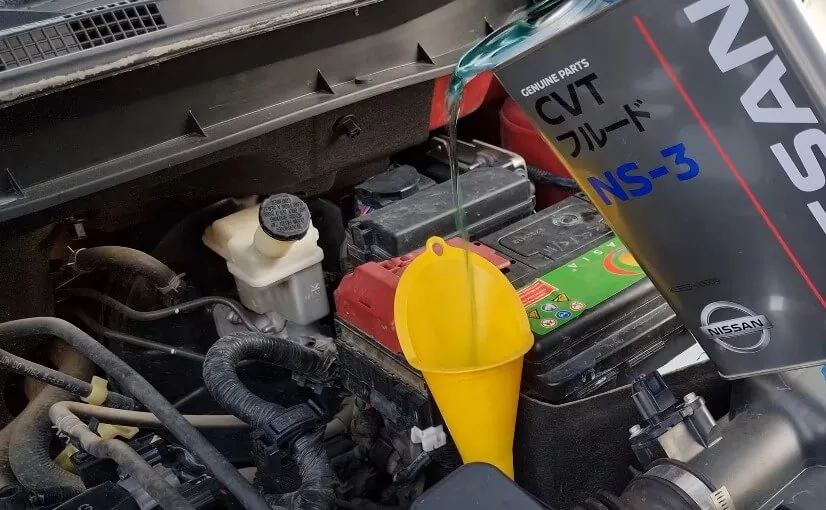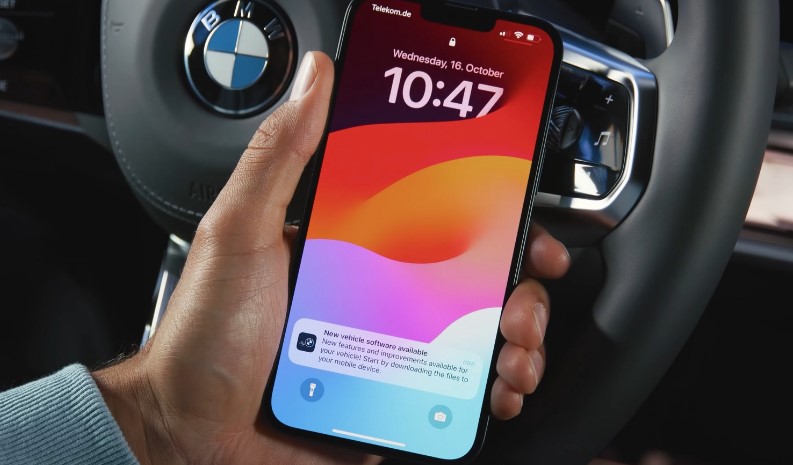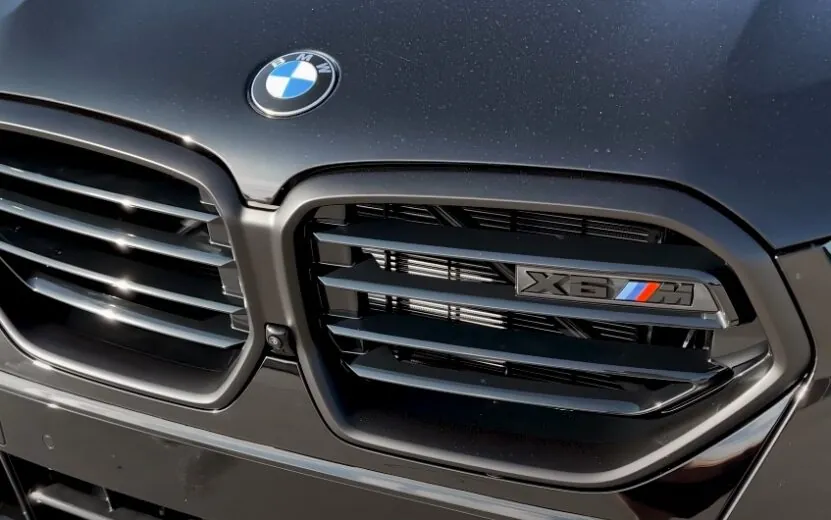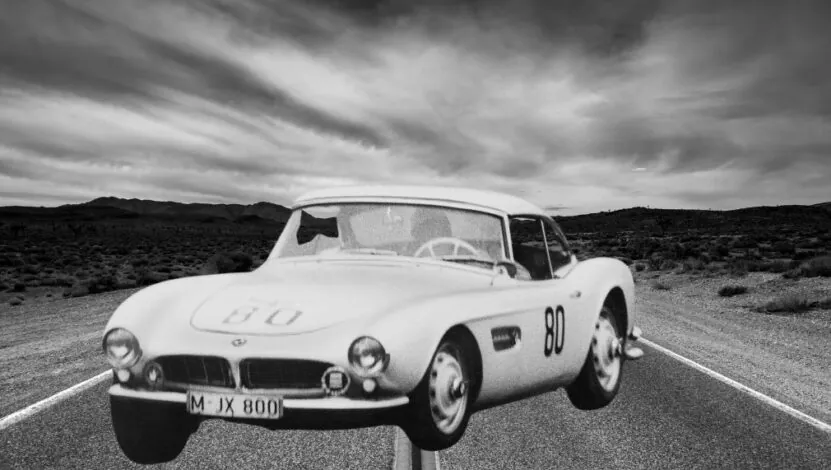
Share Post:
Legends sometimes come in unexpected shapes, and a few of them roll on four wheels. Certain automobiles, when linked with iconic figures, achieve a status that extends far beyond ordinary collector value.
Examples are the Porsche 550 Spyder associated with James Dean, the Ferrari 375 MM once owned by Ingrid Bergman, and Frank Sinatra’s Dual Ghia.
A pair of notable BMWs also claim a spot among those revered machines: the Touring-bodied 328 coupe that triumphed at the 1940 Gran Premio di Brescia, and a 507 roadster associated with the King of Rock and Roll.
Today, we will discuss that elusive 507 and clarify its remarkable path. It involves Hans Stuck Sr., legendary hillclimb champion, an aerospace engineer with a knack for penny-farthing bicycles, and a remote pumpkin warehouse on the West Coast.
Anyone who admires classic BMWs or appreciates a good detective story may find a great deal to savor. Let’s get into it.
Table of Contents
ToggleA Quick Note on Mythic Cars
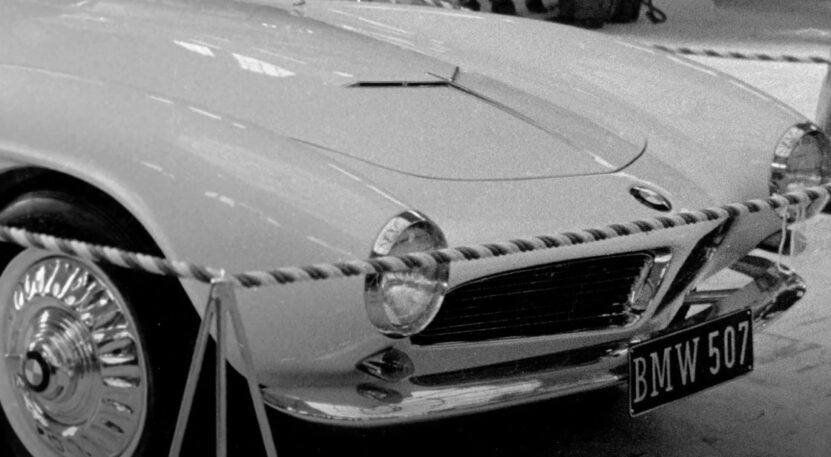
Numerous historical vehicles show up in popular culture, with many commanding seven- or even eight-figure sums at auction. Some become trophy pieces in prominent museums, while others disappear into private collections.
In rare cases, certain four-wheeled icons vanish from public view for decades, leaving enthusiasts and historians anxious to confirm their whereabouts. That sort of mystery surrounded the 507 that Elvis Presley drove while stationed in Germany.
Many believed it was lost for good, or that it ended up repainted, swapped, or otherwise altered beyond recognition. Then, out of nowhere, it showed up under a tarp in a quiet corner of a California warehouse, missing its original powertrain but bearing the all-important stamp: chassis number 70079.
Why the 507 Became a Darling of the Collector World
BMW’s 507 was never a high-volume automobile. Production ended in 1960 after just 251 units rolled off the assembly line. Each had an aluminum body designed by Albrecht Graf von Goertz and carried a silky V8 beneath its long hood.
Back in the late 1950s, many saw it as a future masterpiece of European design. It might not have matched certain Ferrari or Mercedes models in pure horsepower, yet enthusiasts adored its balanced handling, lightweight chassis, and distinctive curves.
Dreams of selling at least 1,000 examples per year never materialized, mostly thanks to production hurdles and a steeper price tag than BMW had initially planned.
Over time, those factors only added exclusivity, turning the 507 into a gem on the classic car market. Owning one now involves serious competition, significant financial resources, and a huge dose of luck.
The mystique grows even more when a particular 507 came from the factory as a racing demonstrator driven by Hans Stuck Sr., then later went home with Elvis Presley during his time in the U.S. Army.
Origins of a Rare Roadster
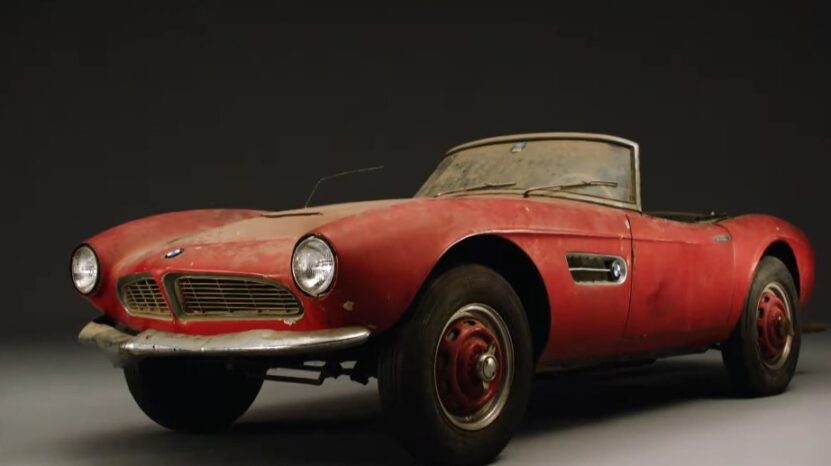
Engineering on a post-war sequel to BMW’s pre-war 328 began as early as 1946. True development started around 1953, though, and the project proceeded in fits and starts.
By 1954, Albrecht Graf von Goertz had been recruited by BMW importer Max Hoffman to shape a sleek roadster aimed squarely at American consumers.
Prototypes bearing numbers 70002 and 70003 graced the 1955 Frankfurt Auto Show and thrilled onlookers. Mass production, however, did not begin until the tail end of 1956.
Management indecision, engineering hiccups, and the costs involved in crafting aluminum coachwork slowed everything down. The earliest production example is chassis 70005, completed on December 11, 1956.
BMW pinned hopes on the new model earning crucial export sales for the American market, and a production run of over 1,000 units per year was the dream.
That never happened, though. Upfront costs pushed the retail price to levels that hamstrung sales. BMW ended 507 production in March 1960, having built a mere 251 in total.
Emergence of Chassis 70079
The chassis at the center of attention here left the BMW factory on September 13, 1957, bearing the official stamp “70079.” Two days before that release date, authorities had assigned license plate M-JX 800.
It arrived from the assembly area in Feather White, which was the most popular color chosen by 507 buyers at the time. Official records point to an original black leather interior, a Becker Mexico radio, Rudge wheels, and a removable hardtop.
A lighted “D” sign on the rear bumper signified a German registration, though that feature would vanish from the car later. On the same day it was completed, the car made its way to the Frankfurt Motor Show, intended as a demonstration piece.
Historians and automotive journalists often mix it up with another white 507 exhibited on the BMW stand. Still, the presence of Rudge knockoff wheels and the distinct license plates on 70079 confirm it spent time outside the hall, used for test drives and promotional events.
At a glance, that might seem normal for a vehicle slated for a small production run. But in the months to follow, that same 507 would cover plenty of ground, star in a movie, earn trophies in hillclimbs, and eventually find its way into the hands of Elvis Presley.
Hans Stuck Sr. and the Racing Chapter
“Bergmeister” at the Wheel
Hans Stuck Sr. had a formidable reputation as a racing driver long before he slipped behind the wheel of 70079. He earned the nickname “Bergmeister” (Mountain Master) for dominating hillclimb events in pre-war Europe.
By the 1950s, Stuck remained a star in motorsport circles despite his advancing age. BMW recruited him to promote and race the new 507, giving 70079 plenty of time on elevated roads.
Stuck participated in events such as the Rossfeld Hillclimb (May 11, 1958), the German Hillclimb Grand Prix at Schauinsland (July 27), and the Swiss Hillclimb Grand Prix at Ollon Villars (August 31).
He took class victories at each outing, proving the 507’s handling prowess, even if it lagged behind certain competitors in raw horsepower.
Press Coverage and Film Cameos
During its time as a factory demonstrator, 70079 also found itself loaned to journalists who shared their impressions with the world. In November 1957, The Autocar published a piece about a spin in that machine.
Its writer marveled at Stuck’s skill and the 507’s dynamic performance. Another curious detour involved the Bavaria Filmstudios project Hula-Hopp Conny, a musical comedy starring Cornelia Froboess and Rudolf Vogel.
Viewers can spot two different 507s in color footage, one being 70079, which features a black-and-white interior during filming. Scratches and dents accumulated along the way, prompting repeated visits to BMW’s workshop for fender repairs, windshield replacements, and an eventual engine overhaul.
By autumn 1958, the company began seeking a buyer. After more than a year of punishing demonstration laps, climbs, and film scenes, the idea of selling it to an adventurous buyer emerged. That buyer turned out to be none other than Elvis Presley.
Elvis in Germany
Military service placed Elvis in Friedburg, Germany, close to Frankfurt, in the late 1950s. At a certain point, he went to Autohaus Wirth, a relatively small dealership, to test-drive a white 507 that had earned itself a robust racing pedigree.
Various rumors suggest a larger dealership, Autohaus Glöckler, might have facilitated the deal. But Karlheinz Lange, a BMW historian with remarkable credentials, confirms the transaction occurred at Wirth.
On December 20, 1958, Elvis took that roadster out for a spin, wearing a uniform that left fans starstruck. Photographers snapped pictures of him smiling behind the wheel.
Dealer plates replaced the original M-JX 800, and soon the U.S. Army assigned Armed Forces plates that read A-1499 (for 1958) and G-1620 (for 1959).
Elvis’s presence in Germany was a media sensation, so a flashy roadster guaranteed immediate attention. That created a funny problem, though: female admirers smeared lipstick messages and kisses all over the white paint, much to Elvis’s chagrin.
Myths Around Ownership
Many stories have sprung up around Elvis’s 507. Some claim he leased or borrowed the car, but credible research indicates he purchased it outright.
Others swear he gave it to actress Ursula Andress in 1963, yet the real serial number associated with Andress points to a different example, 70192, finished in Stone Gray.
Auction houses once labeled 70192 as “Elvis’s 507,” which added confusion. By the 1990s, that misattributed roadster sold at Barrett-Jackson for $350,000 under an incorrect assumption. Meanwhile, the true Elvis/Stuck 507 remained nowhere to be found for decades.
Tommy Charles and a Wild Chevy V8 Conversion
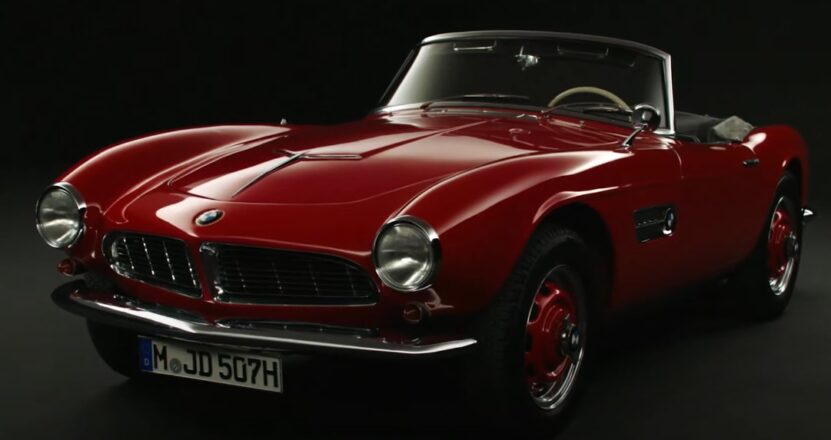
When Elvis departed Germany in March 1960, the 507 probably traveled back to the United States, though official photos of Elvis driving a 507 on American roads are practically nonexistent.
At some point, a Chrysler dealer in New York came into possession of a red 507 with claims it had once belonged to Presley. That’s the story told by Tommy Charles, a radio DJ from Birmingham, Alabama, who purchased an exotic BMW from that dealer in 1962.
In a place where hot rodding was popular, the 507 soon received a swapped powertrain: a supercharged Chevy V8 that vaulted the car to speeds beyond 140 mph. The Borg-Warner gearbox replaced BMW’s original transmission, and the rear axle was welded in place.
Purists might gasp, but cost, convenience, and the local speed culture likely guided that choice. In a region dominated by muscle cars, nobody thought much of modifying an orphaned European roadster.
Provenance linking it to Elvis added a bit of novelty, but it wasn’t the million-dollar advantage it might be today.
Wandering Through Arizona
Eventually, the 507 found its way to Arizona, and by 1968, an aerospace engineer named Jack Castor tracked it down. He was living in Palo Alto, California, and flew to Arizona on a whim to inspect the battered but alluring roadster.
Lloyd Cottle owned it at the time. Castor, who had admired the 507 since his college days in Germany, fell for it on sight. The replacement Corvette engine (no longer supercharged) and various modifications didn’t scare him away.
He hopped in, drove it back to California, and added it to a stable that included vintage Ferraris, classic Kaisers, Alfa Romeo Spiders, and other interesting machines.
A Hidden Treasure in a Pumpkin Warehouse
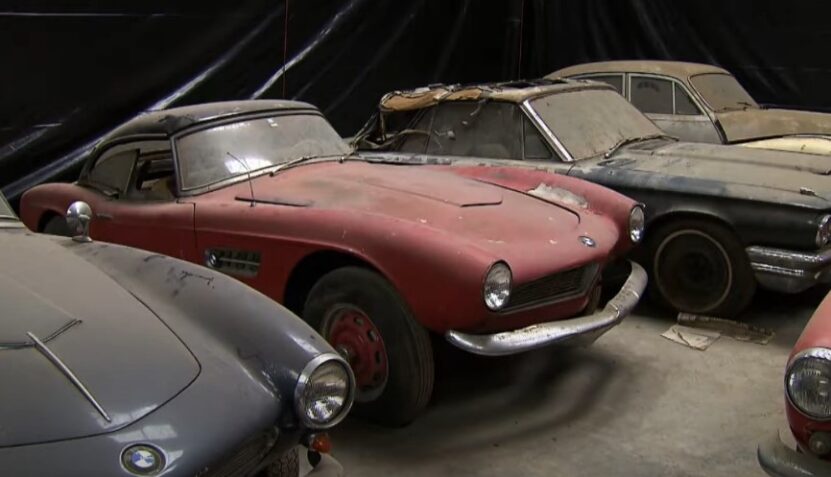
Years rolled by. Life got busy. Castor had every intention of returning the 507 to its former specification, even gathering a BMW gearbox and a period-correct rear end. However, he never found an original 507 V8 block that carried the official “400xx” marking.
He ended up storing the red convertible in a vast building near Half Moon Bay, south of San Francisco. That warehouse mostly housed pumpkins and agricultural goods.
Inside, one would see a row of dusty vehicles, including another 507 owned by Jack’s brother, an Alfa Romeo Giulietta Spider or two, a TR3, an E-type Jaguar coupe, and a few more.
None of them sat in pristine condition, but none were rotting outside in the rain either. Castor valued them enough to keep them safe.
The Revelation
At some point, BMW historians and journalists reached out to Castor, hoping to track down the missing Elvis 507. He offered an invitation for them to come look at his 507, which had a chassis stamp of 70079.
Nobody involved could fully prove that Elvis had driven it. Karlheinz Lange’s research, along with the official factory archive, indicated the 507 raced by Hans Stuck in 1958 carried that exact number and ended up with the King of Rock and Roll in December.
After piecing together old service records, movie stills, color photos showing a black-and-white interior, and official notes about engine replacements and fender repairs, the circumstantial evidence lined up.
By the time journalists finally saw 70079 in person, they lifted the hood, cleared away some grime, and there it was: 70079 stamped on the chassis. Standing before that faded roadster, folks realized how momentous the discovery was.
Decades of speculation ended in that single moment of clarity. A BMW 507 that once raced in hillclimbs, carried Elvis across the roads of Germany, and endured a wild V8 swap in Alabama had been hidden in plain sight.
Examining the Condition
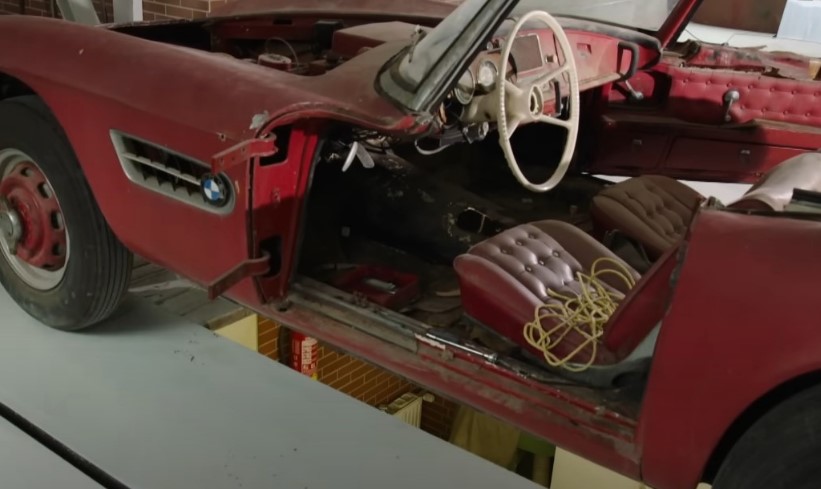
Castor’s 507 still wore the red paint that Elvis allegedly commissioned after his fans used it as a lipstick bulletin board. Under the chipped crimson surface, original Feather White remains visible.
The aluminum panels are still straight, aside from a few areas of minor body filler. Some brightwork is missing. A few dashboard gauges were replaced or relocated to accommodate American hot rod instrumentation.
Nevertheless, the bare structure and primary trim elements appear salvageable.
Missing BMW V8
Original engine 40094 vanished long ago. At some point, a Chevrolet unit took its place. Jack Castor collected a few period BMW V8 blocks, but none matched that special 400xx range that characterized a genuine 507 engine.
An authentic 507 engine is a rare commodity. Only a limited number of spares exist in the world, and they are prized by collectors aiming for 100% matching-numbers restorations.
Back in the 1960s, nobody thought about preserving castings for future concours usage. Still, Jack’s collection includes gearboxes and rear axles from the correct era, ensuring the biggest mechanical hurdle is the engine block itself.
Colorful Interior Makeover
An equally jarring sight is the button-covered seat upholstery. Someone once replaced the original black seats with a flamboyant red-and-white scheme that screams 1960s custom job.
It might be fun in a classic hot rod, but one glance makes it clear that it doesn’t belong in a sophisticated German roadster from the late 1950s. The dash also suffered.
Holes were cut to fit additional gauges, while the original BMW layout was left disfigured. Thanks to the slow pace of Castor’s personal restoration plan, little has changed since the 1970s, giving visitors a time-capsule glimpse of a once-lost Elvis relic.
The Value of Celebrity Provenance
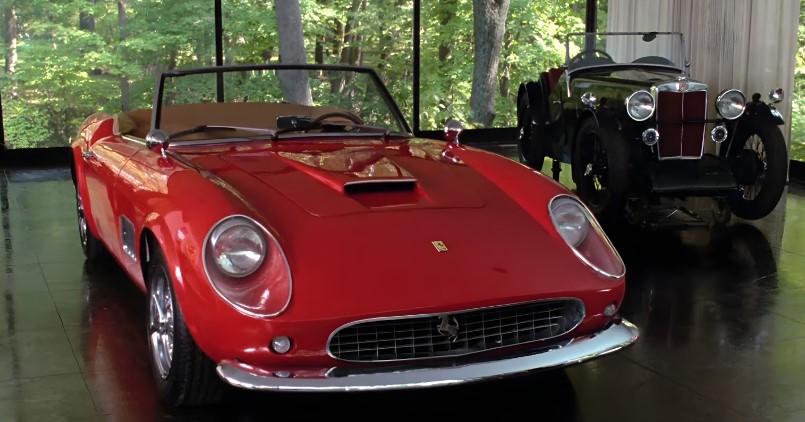
Prices paid for classic cars once owned by famous individuals have skyrocketed in recent decades. Steve McQueen’s Lusso soared at auction for a figure multiple times beyond comparable models, and James Coburn’s Ferrari California Spider achieved a staggering sum.
A 507 with Elvis’s name in the logbook has the potential to break records. That’s especially true when the car also traces a lineage to Hans Stuck’s racing triumphs.
Double provenance of star driver and star entertainer ignites a bidding war among wealthy collectors. Back in the 1960s or 1970s, few recognized that potential.
It’s entirely possible that the Chrysler dealer in New York felt Elvis’s name might boost interest a bit, but the surge in celebrity-focused valuations came decades later.
In 1997, the confusion around chassis number 70192 versus the real 70079 resulted in some disappointment for whomever purchased the Stone Gray 507. One might guess it’s still a marvelous collector car, albeit not the icon it was presented to be.
Piecing Together the Trail
Jack Castor spent a lifetime tracking every shred of documentation for the 507 in his possession. He corresponded with Dr. Karlheinz Lange, combed through old racing reports, and tried to secure U.S. Army records that might confirm the plates assigned to Elvis in Germany.
Rules regarding personal data, military archives, and privacy often stand in the way of conclusive evidence, but the jigsaw puzzle remains nearly complete.
Those who read old newspaper articles from Alabama in the early 1960s found references to a BMW convertible that carried a claim of Elvis ownership.
Some might dismiss that as rumor, but it lines up too perfectly with the mechanical conversions done by Tommy Charles. Then there’s the fact that multiple restorers or investigators have seen the red 507 in Jack’s warehouse, complete with a Chevy V8 still resting in the engine bay or lying nearby.
The chassis number is plainly visible. Photos of Elvis in Germany show a white 507 with the same interior layout, the same Rudge wheels, and the same fender shape.
Later pictures reveal the same car sporting red paint while using 1959 Armed Forces plates. All roads keep leading back to 70079.
Preservation, Not Profit
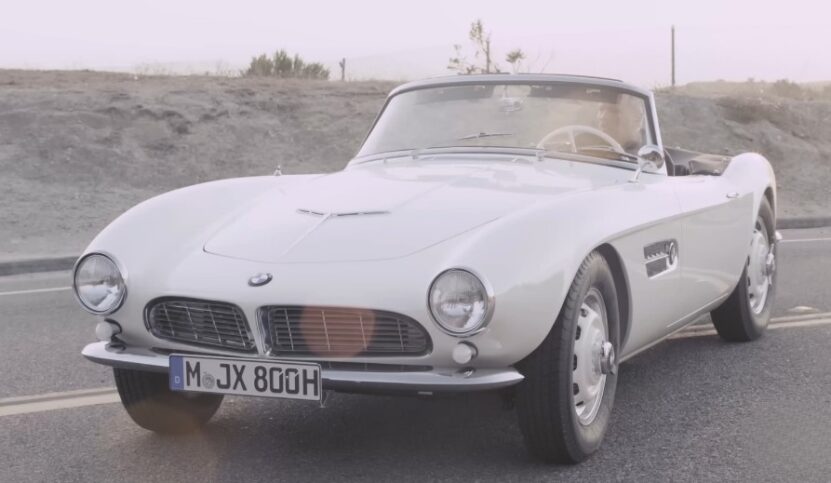
Jack Castor never rushed to sell. In interviews, he laughed when people mentioned an astronomical value for 70079. He preferred to see it remain in his care.
The quiet, unassuming engineer viewed it as a piece of automotive history that demanded thoughtful restoration. A big payday might tempt other owners, yet Castor repeated that he valued the story and the machine more than any check.
Friends recall how he treasured the 507’s engineering details. He scoured swap meets and collectors’ garages, hoping to locate anything that belonged on an original 507.
Over time, he amassed a trove of relevant parts. Meanwhile, the car remained tucked away, attracting a swirl of curiosity among those who knew its significance.
Goals for a Full Restoration of 70079
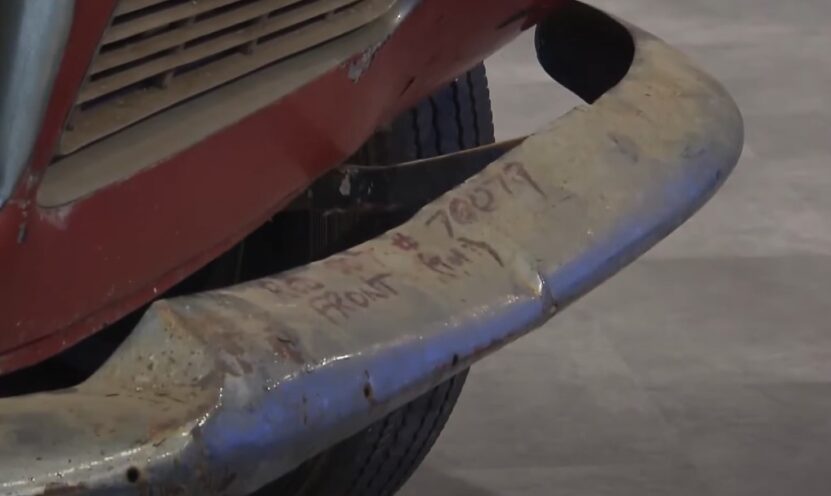
1. Securing a Correct Engine Block
The biggest challenge lies in tracking down a legitimate 507-spec V8. Even a blank block from that series would be a victory for authenticity, though an exact match to engine 40094 would be a dream scenario.
2. Reverting the Chassis Modifications
The Borg-Warner transmission and welded Chevy rear axle must be replaced with components from BMW’s period hardware. That ensures geometry and suspension feel remain consistent with the 507’s original design.
3. Restoring the Interior
Eliminating the 1960s two-tone upholstery would likely be a top priority. Sourcing a proper dash, gauge cluster, and seat trim might require specialized craftsmanship or reproduction parts, all anchored in historical accuracy.
4. Reclaiming Feather White
Returning the paint to its original color is likely. Some owners might opt to keep the red paint that Elvis chose, though pure authenticity points to the factory color.
Photographs of the King’s white 507 with lipstick marks might motivate a restorer to pay homage to that ephemeral era. Deciding on that might take a bit of reflection.
5. Recreating the “D” Sign
The luminous “D” that once graced the rear bumper is a fascinating detail. Period photos confirm its presence in the film Hula-Hopp Conny and during factory demonstration outings. It’s a small item, but it ties the car closely to its German origins.
Balancing History and Practicality
Some collectors prefer to keep a vehicle’s patina and blemishes to emphasize authenticity. Others aim for a concours-quality restoration that glistens under show lights.
70079 has multiple chapters in its story, from Stuck’s hillclimb exploits to Elvis’s daily commutes, from a 1960s hot rod conversion to decades of quiet hibernation. Which chapter resonates most strongly with a restorer? That remains a fascinating question.
A Short Reflection on Historic Cars
Handfuls of cars in the world can claim a place in pop culture and motorsport annals with equal flair. Most either belonged to household-name individuals or triumphed in famous competitions.
The 507 that Stuck raced and Elvis owned checks both boxes. It won major hillclimbs in 1958 under the watchful eye of an ace driver, then launched a swirl of fan frenzy when Presley cruised German roads wearing his Army uniform.
After that, it underwent a radical engine swap typical of American car culture. Eventually, it faded into near oblivion, overshadowed by swirl and rumor.
Then, one day, a tarp pulled back, a chassis plate was spotted, and a revered missing icon came back to the surface.
Summary
Elvis’s BMW 507 exemplifies the unique legacy a single automobile can hold. Photographs, service records, racing notes, and testimony from dedicated historians point firmly to chassis 70079 as that legendary machine.
It survived a complicated life, from racetrack stardom to a rock star’s daily driver, from hot rod experimentation to decades of sleepy storage. Jack Castor’s dedication preserved it for future generations, standing as a testament to curiosity and meticulous research.
There’s little doubt that a full restoration would spark massive excitement among car buffs worldwide. It’s hard not to marvel at a story that merges the flamboyance of Elvis Presley, the skill of Hans Stuck, and the persistent efforts of an engineer who simply cherished a rare gem.
In many respects, that 507’s saga represents the best kind of automotive lore: a car that drifted off into legend only to resurface years later. Fans had whispered about it, doubters claimed it was gone forever, and others thought Elvis’s wheels had to be locked away at Graceland.
Thanks to patient sleuthing and a bit of good fortune, the real champion is alive and well, hiding in plain sight until the day comes when it finally returns to the open road.
And when that day arrives, it will shine again, reflecting an era gone by and the spirit of two legends—one from the mountain passes, and one from the stage—who once claimed it as their own.
Related Posts:



